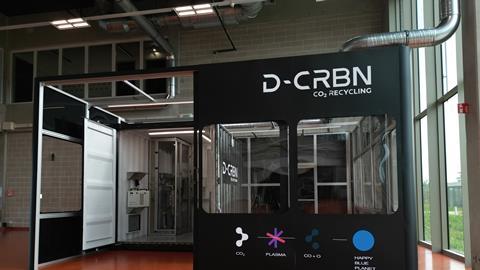As one of 42 companies – out of 1083 applications – and the only Belgian company, D-CRBN will receive a grant from the EIC Accelerator programme. The European Commission sees great potential in the plasma technology used by the innovative company to convert captured CO2 into CO.
Many industrial companies are exploring the potential of CO2 capture and storage to reduce their emissions. But converting CO2 into a feedstock for your own process can be much more efficient than storing it. ‘In many industrial sectors, such as petrochemicals or steel, CO is an important feedstock. It is currently produced from fossil sources. With our plasma technology, waste CO2 can be converted into CO’, says David Ziegler, Chief Commercial Officer of D-CRBN, a spin-off from the University of Antwerp.
Mobile unit
The potential of the innovative plasma technology has not gone unnoticed by the European Commission, which is why D-CRBN is entitled to a grant from the EIC accelerator programme. The innovative company was the only Belgian party selected for funding out of 1083 applications. In addition to the €2.5 million grant, the company can also look forward to an investment from the European Investment Bank, among others. D-CRBN will start negotiations on this shortly. The spin-off will use the funding to develop a mobile demonstration unit for its plasma technology. This will have the capacity to convert 10,000 tonnes of CO2 into CO per year.
Methanol
D-CRBN emerged three years ago from years of research by the PLASMANT group at the University of Antwerp. Plasma is a highly reactive state of matter created, for example, by lightning. When CO2 is brought into this state, it can be split into CO and oxygen. ‘Unlike CO2, CO is an important raw material, for example in the chemical industry. With hydrogen it can be made into methanol, for example’, says Ziegler. For the past six months, the company has been operating a pilot plant with a capacity of 1,000 tonnes of CO2 per year at Blueapp, an open innovation centre at the University of Antwerp. ‘With this grant, we want to continue scaling up and take the step from TRL6 to TRL8-9 [Technology Readiness Level, from demonstration to commercial application, ed.].’
Scaling up
D-CRBN sees itself as a small link in the value chain and therefore works with all parties in the CCU/CCS chain: industrial companies that want to reduce their CO2 emissions, companies that capture and clean CO2 and companies that can (temporarily) store and transport CO2. Partners include energy company Engie, tank storage group Vopak, chemical giant BASF and steel producer Arcelor-Mittal.
Article continues below

For the time being, D-CRBN’s plasma technology is only a small-scale solution to the CO2 problem. Ziegler: ‘A steel company’s blast furnace emits about 1 million tonnes of CO2 a year. Our process is still small, of course. But we can scale it up very easily. We have now built an optimal reactor. We will scale it up not by making it bigger, but by running several units in parallel. Another major advantage of our reactor is that the CO2 supplied does not have to be of food-grade purity. The 98.5% purity now achieved in industrial CO2 capture is sufficient.’
Commercial product
The company will soon announce where it will locate the new pilot plant. It will have the capacity to recycle 1,000 tonnes of CO2 per year. Ziegler: ‘We will learn a lot from this project, because it will run on an industrial site. We will then use this knowledge to work on our first commercial product, which we plan to launch in late 2025, early 2026. This plant, with a processing capacity of 10,000 tonnes of CO2 per year, will be designed as a container concept so that it is easy to move. It will be a ’plug and play’ design so it can be used immediately. We believe we can offer an interesting business case by providing carbon to customers who no longer need to use fossil fuels to generate it and reduce their emissions. The benchmark is deliberately not based on CO2 valuation, mainly because of fluctuating prices.’













Nog geen opmerkingen